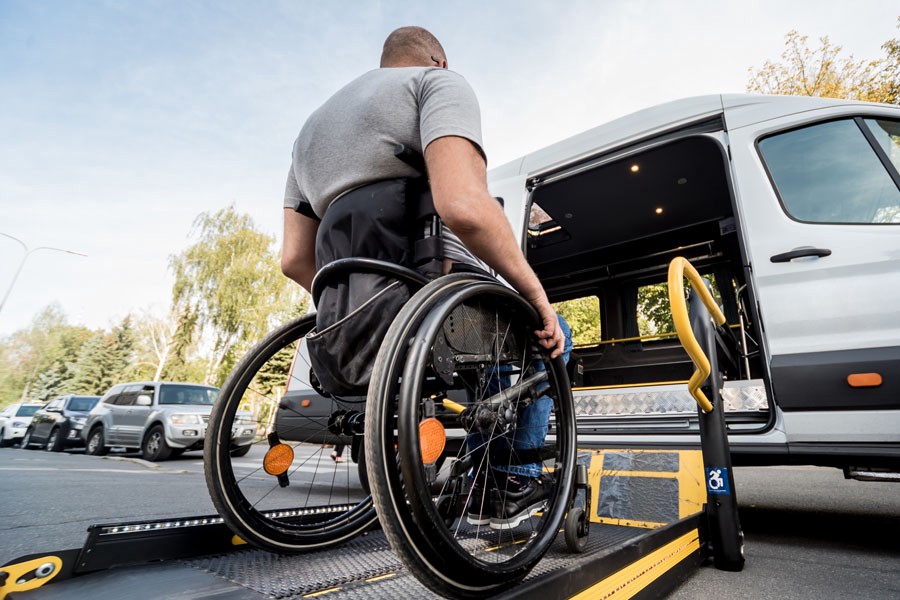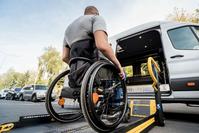Designing AVs so persons with disabilities can travel anywhere they wish
The promise of freedom of travel using AVs — via an accessible, inclusive design — is an exciting prospect that will dramatically enhance their independence, employment potential, and overall health and well-being.

Persons with disabilities face a variety of specific transportation challenges, including entering and exiting public vehicles like buses and shuttles, obstacles when maneuvering within these vehicles, and lack of access to information and communication services provided for public transit passengers (such as route planning and destination announcements).
Current modes of accessible commercial transportation also have limitations, such as specified routes and schedules of operation that restrict where and when persons with disabilities can travel. Paratransit transportation is more accommodating, but it presents constraints regarding service locations and times, and it limits who can travel with a person.
Personal transport alternatives, like wheelchair-accessible vehicles (WAVs), have drawbacks, too. With accessible driving systems, wheelchair users with manual dexterity sometimes can drive themselves, but these systems are very expensive — often costing more than the vehicle itself! Also, WAVs are very helpful for wheelchair users, but not for individuals with other types of disabilities, such as blindness or visual impairment, or for persons with cognitive impairments, ranging from epilepsy to intellectual challenges.
 Efficient, Accessible and Safe Interaction in a Real Integrated Design Environment for Riders with disabilities
Efficient, Accessible and Safe Interaction in a Real Integrated Design Environment for Riders with disabilities
At Purdue, we are developing a platform called EASI RIDER — Efficient, Accessible and Safe Interaction in a Real Integrated Design Environment for Riders with disabilities. The design goals are:
- An advanced, fully automated ingress/egress ramp that enables seamless entering and exiting of the vehicle
- An intelligent “Smart Ramp” deployment system that can identify an appropriate parking location
- An automated securement system to independently secure wheelchair users in the vehicle
- A state-of-the-art user interface to control secondary functions, entertainment, and remote communication during emergencies
Our proposed inclusive design solutions focus on addressing functional disabilities that make independently driving a traditional passenger vehicle difficult or impossible, particularly for persons who have mobility impairments or are blind or visually impaired. The accessibility features we have developed also can be leveraged by people with a wide range of disabilities — such as individuals with hearing and speech impairments — through a user interface that consists of touch and voice controls.
We entered our platform in the U.S. Department of Transportation (DOT) Inclusive Design Challenge, which is seeking ways to enable people with physical, sensory and cognitive disabilities to use highly Automated Driving Systems-Dedicated Vehicles (ADS-DVs) to access jobs, healthcare, and other critical destinations. We completed a Stage I proof-of-concept and have advanced to Stage II, prototype demonstration. In June 2022, we and other semifinalists will demonstrate our prototypes, with $2 million to be awarded to the top three teams.
Our project offers an integrated inclusive design that involves multiple elements necessary for a traveler with a disability to enter the vehicle, maneuver and be seated, control all functionality of an AV, and disembark at the designated destination independently and safely. We are working with several industry partners to develop a life-sized, operational demonstration platform. We’re tapping our partners’ expertise in various areas, including wheelchair entry and exiting, Smart Ramp deployment, and wheelchair securement; alternative vehicle controls; vehicle platforms; powered wheelchair innovations that incorporate robotics and camera systems; and speech-generating devices.
Our other design criterion is efficiency. Current modes of accessible transportation often do not provide an easy or pleasant experience. Persons with disabilities frequently feel as if they are delaying or inconveniencing other passengers. They also may not feel comfortable in reaching their destinations, or even feel safe while traveling. In general, there is a lot of anxiety associated with travel, even if everything goes well. To address these concerns, in addition to state-of-the-art technological solutions, we are focused on applying human factors and systems engineering approaches to this challenge.
For this reason, it is critical that we solicit opinions from our targeted design population, and incorporate their feedback into our design — a step too often neglected in the product development process. We’re collaborating with community advisors, including Bosma Enterprises, which helps people navigate blindness and visual impairment by providing job training, employment services, and rehabilitation; Easterseals Crossroads, which helps individuals with disabilities and special needs and their families live better lives; and Wabash Area Lifetime Learning Association (WALLA), which provides learning opportunities and community support for adults aged 50 and older.
There is no clear and agreed-upon vision for how AVs will be used in the future, including for those with disabilities. But we hope that we will be pioneers in this space, and that our project will help guide what this future will look like. Certainly, for example, people have envisioned AVs being available as a ride-sharing service, yet Uber and Lyft are not presently available to wheelchair users, and there have been cases of discrimination against persons with disabilities by such services. Accessible AVs could extend these and other current modes of transportation.
The overall potential impact of AV technology such as we’re developing is to enable persons with disabilities to travel wherever there is a road and whenever they choose, and to enjoy the same freedoms as everyone else — whether it is to grab a late-night taco or travel across the country.

Brandon J. Pitts, PhD
Assistant Professor, School of Industrial Engineering
Member, Purdue Engineering Initiative in Autonomous and Connected Systems (ACS PEI)
College of Engineering, Purdue University

Brad Duerstock, PhD
Associate Professor of Engineering Practice, School of Industrial Engineering
Joint Appointment with Weldon School of Biomedical Engineering
College of Engineering, Purdue University
Related Links
Duerstock-Pitts team named semifinalist in DOT’s Inclusive Design Challenge
Inclusive Design Challenge
NHanCE Research Lab
Duerstock Institute for Accessible Science (IAS) Lab
Autonomous and Connected Systems PEI: Faculty accomplishments

